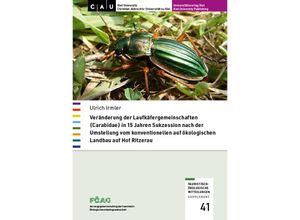The study compiles the results of a fifteen years research on ground beetles after the
conversion from conventional to organic farming on Ritzerau Manor (south-eastern
Schleswig-Holstein Germany). The results display the succession of the single ground beetle
species and of the changes in the species diversity. The changes of the single ground beetle
species can be differentiated into specific ecological groups. These are species (1) with
declining abundance during the succession or retreat from the arable fields into marginal areas
near their original source habitats. Among these are dominant species from conventional fields
e.g. Pterostichus melanarius or (2) species orginating from woods e.g. Carabus coriaceus.
Among the ecological group that depends on open habitats (3) are species preferring high
temperature from oligotrophic grassland or heath benefit from organic agriculture. Many species
invaded into the organically managed arable fields showed increasing abundance or wider
distribution. Aditionally species from fallow grassland belong to this ecological group.
Furthermore characteristic species from (4) organic arable fields or nearly extinct species
which were common in the past under less intensive agriculture e.g. Zabrus tenebrioides have
recently invaded and have highly increased their abundance e.g. Carabus auratus. (5) Some
species from moist grassland have also widened their resources into the organic fields in rainy
years but certainly cannot inhabit the field permanently. In the specific case of the arable
fields of Ritzerau Manor species mainly invaded the arable area from the south-western
direction where dry and open grassland border the area or via the upper parts of the
Duvensee-Creek channel in the Northeast. No invasion was observed from the Northwest where
large woods are adjacent to the arable area and from the Southeast where the wet area of the
wide swampy area of the Duvensee-Creek or the shallow lake Duvensee operate as barrier to the
research area. In general the changes in the species composition of organic arable fields
strongly depend on the entries into the area and the ecological conditions in the adjacent
source ecosystems. The invasion of new species after conversion to organic management will be
faster if adequate ecosystems are in the nearer sourrounding and slower if such near natural
habitats are in high distance. For the future a further invasion of species from meso- to
oligotrophic ecosystems can be expected. This is in particular beneficial for nature
preservation because the ecological species group from oligotrophic habitats is exceptionally
species-rich and endangered in the present nutrient-rich agricultural landscape. The analysis
of the changes in the species diversity exhibits that the increase in the diversity on organic
fields increase from the marginal to the central area. The area with low species richness in
the conventional field centres became successively smaller with time which also affected
positively the total diversity of the landscape. Considering this effect organic agriculture
is not only beneficial for the arable field area itself but also for the total landscape.



